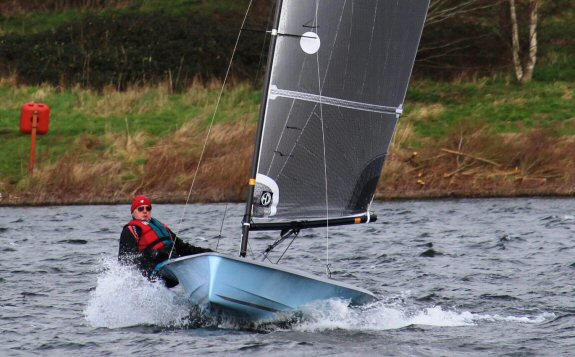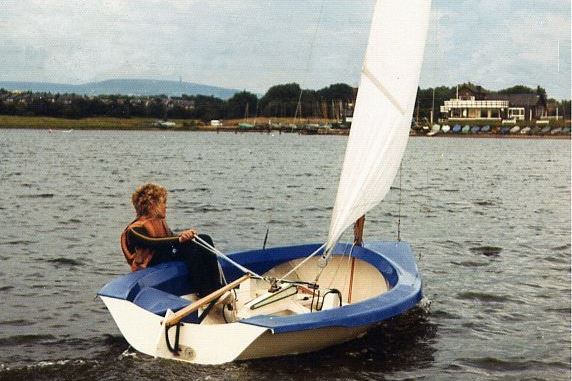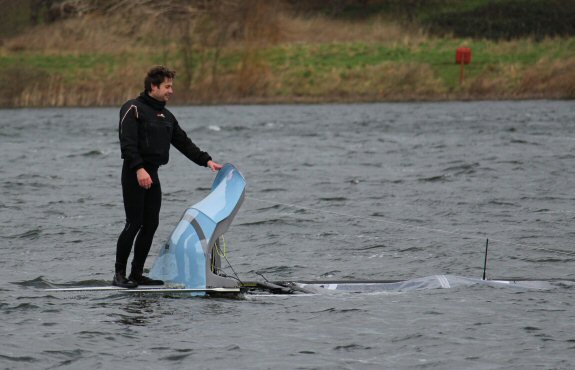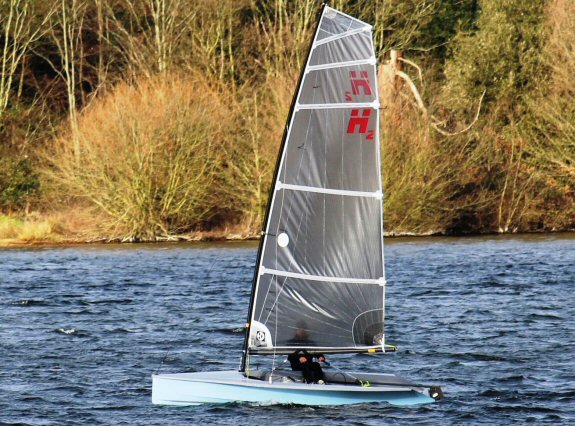When H2 met the Eau!
Yet another new single hander? H2, a different approach to the genre.
By David Henshall

|
Back in the early 1970s, the father of top dinghy sailor Lawrie Smith was finding that as he grew older, his OK dinghy was becoming a bit too much of a handful. He turned to one of the top Merlin Rocket designers, Keith Callaghan, for a new single hander that would be more easily managed yet would still provide a good degree of excitement afloat. The resulting design for the Harrier dinghy would enjoy a number of years of loyal following, even though the basic concept had been let down by poor build issues, hull weight and a lack of sophistication in the rig. Even so, more than 70 boats were sold and for many years the class remained popular in the North of England.

|
From the blond curls to the Flotherchok life jacket to the 'solid' (and heavy) blue gel coat, this picture of a young Lawrie Smith sailing his father's Harrier dinghy screams 1970s. And it is - 1972, at Elton Sailing Club near Bury. |
Fast forward to more recent times and Keith, who had also been a leading crew in the Merlin Rocket Class, was given the chance to get back into a boat for the (in)famous Salcombe Week. What better way to get fit than to do a bit of single handed sailing, which led Keith to rethink the Harrier concept as a boat for today. The Hadron was conceived as an easy to build, attractive boat that would appeal to the helm who liked to be able to make his boat into an individual statement. Certainly, when Tom Gruitt tested the new boat for Yachts and Yachting, he found it to be a boat capable of "putting a smile on your face".
However, the dinghy world has moved on from the days when ease of home building was a major plus point, with the notion that 'frp is faster' being borne out by experiences afloat. In theory, it would have been possible to make a Hadron using foam construction, but at the same time, there was a great opportunity to learn from the sailing experiences gained with Hadron to ensure a much better all-round product. Before racing back to the drawing board, designer Keith Callaghan spent a long time working through the criteria to ensure that he could meet a number of new and exacting standards. The boat had to be sailable by a wide range of skill levels and weights, in both light airs and full on breezes. This meant that with a well-designed, easily driven hull form, a more modest rig could be stepped. Vice free handling afloat had to be complimented by ease of handling ashore, so a conventional centreboard replaced the easier option of a dagger board. Similarly, the boat would not have a spinnaker, and just be rigged with a single square top mainsail that would provide the required gust response.

|
The trend with many modern dinghies is for them to 'float high', which can make recovery difficult for those not in the 'elite athlete' category. Designer Keith Callaghan has carefully positioned the buoyancy so that the H2 floats level and will be slower to invert. |
The use of flooding side tanks and a central buoyancy 'console' would result in a hull that would float on its side with a degree of stability, with the plate just above the surface of the water. With the use of advanced build techniques using carbon/Aramid materials allied to an all new design, the result, the H2, (all of Keith's designs start with the letter H) from the outset looked to be not just a very 'pretty' boat but one with a sub 60 kg hull weight.
Sadly, the recent run of excessively windy weather forced a number of cancellations for the all important launch date. Then the forecasts suggested a brief window of opportunity, with winds in the upper range of what would be acceptable and a high chill factor, but this was still better than the weather that would follow.

|
Good champagne is best served cold which was not a problem on the day of the launch, as Brenda Callaghan, wife of the designer, christened the boat. Despite the conditions, sailing the new H2 was certainly a 'champagne moment'. |
A number of those who had been involved in the project braved the biting wind at Alton Water to see Brenda Callaghan christen the new boat with bubbly before builder Simon Hipkin took it out on the lake for its first sail. As an independent tester, I got the second go, before Jim Hunt, then Chris Gould, both of HD sails (who have been busy working with Keith on the rig) put the boat through its paces.

|
The team from HD sails give the H2 a more searching test of capabilities out on the lake at Alton Water. |
Helm weights on the day ranged from a little under 70 kgs to an admitted bit over 90 kgs (not saying who that was!) but we all found the boat delightfully responsive and comfortable to sail. Given the temperature of the water and the chill in the air, the extra freeboard that kept the helms out of the wet stuff and the flared hull form that gave the helm a dry ride were both well appreciated. This was, after all, the very first sail and a number of issues immediately became apparent, but with control lines repositioned, a change to the rudder tie down (production boats may well have a dagger rudder in a cassette) and a rethink on the toe straps and the boat will be ready for an intensive programme of more testing outings across a range of venues and conditions.
Text by David Henshall. Pictures courtesy Keith Callaghan.
The second hull is already out of the mould at White Formula, although fitting out will wait until after further testing of the prototype.

|
The second H2 hull has already been laid up by the team at White Formula, with further boats to follow shortly. |
The first orders have already been taken for the boat, with potential purchasers able to make clear from the outset how they would like their boat to be set up. Given that as soon as boat 2 is in the water the testing process will be stepped up even further, the intention is for production boats to be coming out of the Brightlingsea yard around Easter time 2016.
© This site is the copyright of Keith Callaghan. This article is the copyright of D. Henshall, February 2016. .